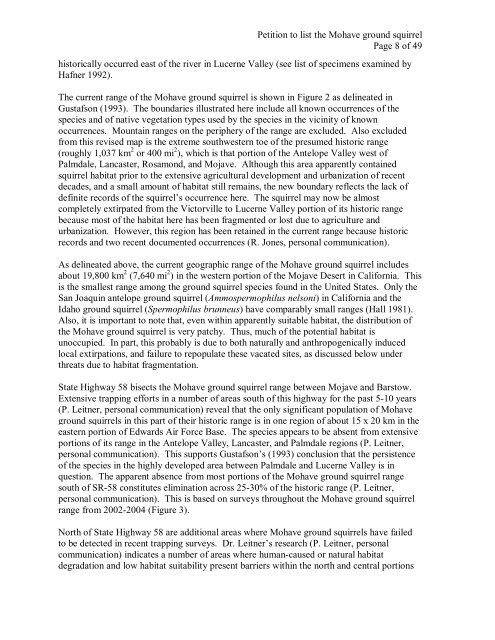Petition to list the Mohave Ground Squirrel - Defenders of Wildlife
Petition to list the Mohave Ground Squirrel - Defenders of Wildlife
Petition to list the Mohave Ground Squirrel - Defenders of Wildlife
Create successful ePaper yourself
Turn your PDF publications into a flip-book with our unique Google optimized e-Paper software.
<strong>Petition</strong> <strong>to</strong> <strong>list</strong> <strong>the</strong> <strong>Mohave</strong> ground squirrel<br />
Page 8 <strong>of</strong> 49<br />
his<strong>to</strong>rically occurred east <strong>of</strong> <strong>the</strong> river in Lucerne Valley (see <strong>list</strong> <strong>of</strong> specimens examined by<br />
Hafner 1992).<br />
The current range <strong>of</strong> <strong>the</strong> <strong>Mohave</strong> ground squirrel is shown in Figure 2 as delineated in<br />
Gustafson (1993). The boundaries illustrated here include all known occurrences <strong>of</strong> <strong>the</strong><br />
species and <strong>of</strong> native vegetation types used by <strong>the</strong> species in <strong>the</strong> vicinity <strong>of</strong> known<br />
occurrences. Mountain ranges on <strong>the</strong> periphery <strong>of</strong> <strong>the</strong> range are excluded. Also excluded<br />
from this revised map is <strong>the</strong> extreme southwestern <strong>to</strong>e <strong>of</strong> <strong>the</strong> presumed his<strong>to</strong>ric range<br />
(roughly 1,037 km 2 or 400 mi 2 ), which is that portion <strong>of</strong> <strong>the</strong> Antelope Valley west <strong>of</strong><br />
Palmdale, Lancaster, Rosamond, and Mojave. Although this area apparently contained<br />
squirrel habitat prior <strong>to</strong> <strong>the</strong> extensive agricultural development and urbanization <strong>of</strong> recent<br />
decades, and a small amount <strong>of</strong> habitat still remains, <strong>the</strong> new boundary reflects <strong>the</strong> lack <strong>of</strong><br />
definite records <strong>of</strong> <strong>the</strong> squirrel’s occurrence here. The squirrel may now be almost<br />
completely extirpated from <strong>the</strong> Vic<strong>to</strong>rville <strong>to</strong> Lucerne Valley portion <strong>of</strong> its his<strong>to</strong>ric range<br />
because most <strong>of</strong> <strong>the</strong> habitat here has been fragmented or lost due <strong>to</strong> agriculture and<br />
urbanization. However, this region has been retained in <strong>the</strong> current range because his<strong>to</strong>ric<br />
records and two recent documented occurrences (R. Jones, personal communication).<br />
As delineated above, <strong>the</strong> current geographic range <strong>of</strong> <strong>the</strong> <strong>Mohave</strong> ground squirrel includes<br />
about 19,800 km 2 (7,640 mi 2 ) in <strong>the</strong> western portion <strong>of</strong> <strong>the</strong> Mojave Desert in California. This<br />
is <strong>the</strong> smallest range among <strong>the</strong> ground squirrel species found in <strong>the</strong> United States. Only <strong>the</strong><br />
San Joaquin antelope ground squirrel (Ammospermophilus nelsoni) in California and <strong>the</strong><br />
Idaho ground squirrel (Spermophilus brunneus) have comparably small ranges (Hall 1981).<br />
Also, it is important <strong>to</strong> note that, even within apparently suitable habitat, <strong>the</strong> distribution <strong>of</strong><br />
<strong>the</strong> <strong>Mohave</strong> ground squirrel is very patchy. Thus, much <strong>of</strong> <strong>the</strong> potential habitat is<br />
unoccupied. In part, this probably is due <strong>to</strong> both naturally and anthropogenically induced<br />
local extirpations, and failure <strong>to</strong> repopulate <strong>the</strong>se vacated sites, as discussed below under<br />
threats due <strong>to</strong> habitat fragmentation.<br />
State Highway 58 bisects <strong>the</strong> <strong>Mohave</strong> ground squirrel range between Mojave and Bars<strong>to</strong>w.<br />
Extensive trapping efforts in a number <strong>of</strong> areas south <strong>of</strong> this highway for <strong>the</strong> past 5-10 years<br />
(P. Leitner, personal communication) reveal that <strong>the</strong> only significant population <strong>of</strong> <strong>Mohave</strong><br />
ground squirrels in this part <strong>of</strong> <strong>the</strong>ir his<strong>to</strong>ric range is in one region <strong>of</strong> about 15 x 20 km in <strong>the</strong><br />
eastern portion <strong>of</strong> Edwards Air Force Base. The species appears <strong>to</strong> be absent from extensive<br />
portions <strong>of</strong> its range in <strong>the</strong> Antelope Valley, Lancaster, and Palmdale regions (P. Leitner,<br />
personal communication). This supports Gustafson’s (1993) conclusion that <strong>the</strong> persistence<br />
<strong>of</strong> <strong>the</strong> species in <strong>the</strong> highly developed area between Palmdale and Lucerne Valley is in<br />
question. The apparent absence from most portions <strong>of</strong> <strong>the</strong> <strong>Mohave</strong> ground squirrel range<br />
south <strong>of</strong> SR-58 constitutes elimination across 25-30% <strong>of</strong> <strong>the</strong> his<strong>to</strong>ric range (P. Leitner,<br />
personal communication). This is based on surveys throughout <strong>the</strong> <strong>Mohave</strong> ground squirrel<br />
range from 2002-2004 (Figure 3).<br />
North <strong>of</strong> State Highway 58 are additional areas where <strong>Mohave</strong> ground squirrels have failed<br />
<strong>to</strong> be detected in recent trapping surveys. Dr. Leitner’s research (P. Leitner, personal<br />
communication) indicates a number <strong>of</strong> areas where human-caused or natural habitat<br />
degradation and low habitat suitability present barriers within <strong>the</strong> north and central portions
















